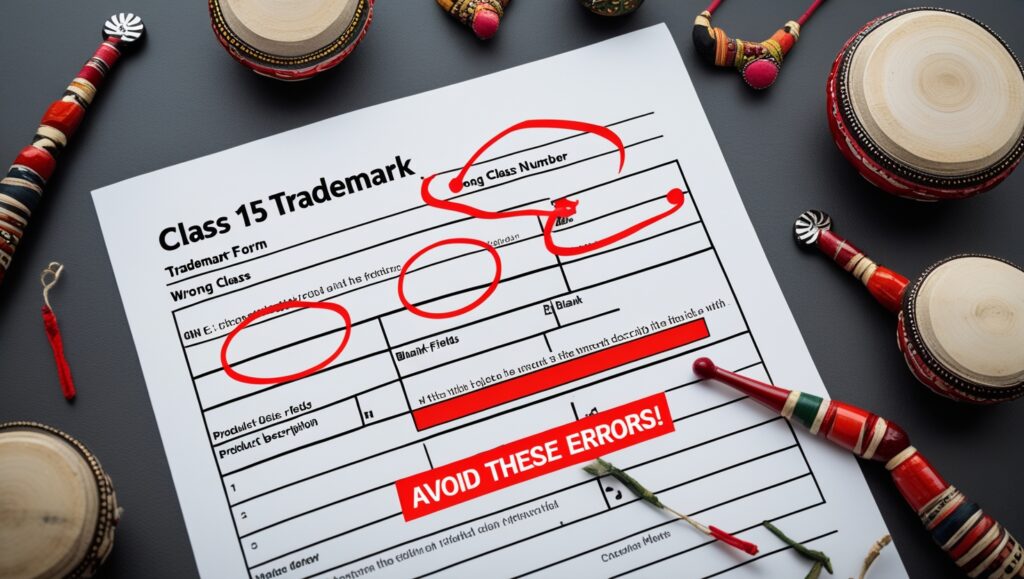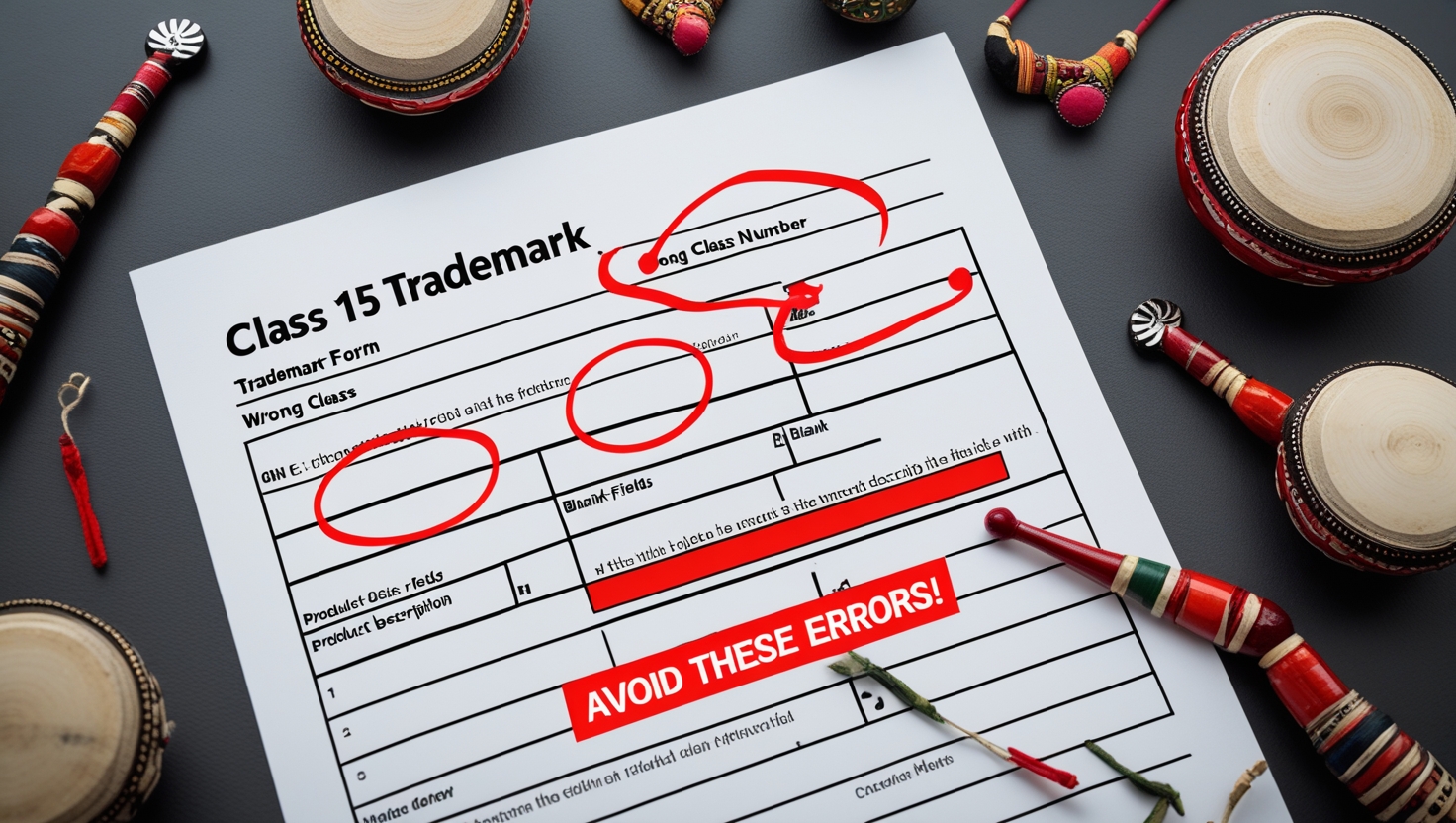Top Errors to Watch Out for When Filing a Class 15 Trademark in India
Protecting your brand in the music world—whether you’re crafting tabla, electric guitars, or digital keyboards—means filing your trademark under Class 15. Get it wrong, though, and you’ll face delays, objections, or even rejections. This guide highlights the top mistakes applicants make in Class 15 filings and shows you exactly how to dodge them for a smooth, successful process.

1. 🚫 Filing Under the Wrong Class
Mistake: Using Class 15 for unrelated goods (like merchandise, software, or sound systems).
Why It Matters: Your application may be rejected or result in weak protection.
Solution:
- Class 15 covers: musical instruments, accessories (tuners, drumsticks), cases, stands, tuning forks, electronic instruments (synthesizers, MIDI controllers).
- For software: use Class 9. For educational services: Class 41. For clothing: Class 25.
2. 🔍 Skipping a Thorough Search
Mistake: Conducting only a quick search or none at all before filing.
Why It Matters: You risk infringement complaints or having your application opposed.
Solution:
- Search using wordmarks, phonetics, and Vienna Codes on the IP India portal.
- Look beyond exact matches—check possible transliterations, misspellings, or abbreviations.
- Keep records of search results to back your filing.
3. ❌ Choosing a Generic or Descriptive Mark
Mistake: Names like “TablaPro” or “GuitarGenius”—too obvious or descriptive to register.
Why It Matters: Such marks are considered weak and often face rejection.
Solution:
- Opt for coined or suggestive names: TablaCraft, RagaWave, or StratoTune.
- Ensure your name isn’t overly descriptive of the product’s feature or function.
4. 📦 Vague Product Descriptions
Mistake: Application describes goods simply as “musical instruments.”
Why It Matters: Vague listings leave gaps in protection and trigger examiner queries.
Solution:
- Be specific: “Electric guitars; acoustic guitars; guitar amplifiers; guitar strings.”
- Detailed listings are less likely to be objected to and offer clearer coverage.
5. 🔄 Mixing Diverse Goods in One Class
Mistake: Combining instruments with clothing, software, or electronics in a single Class 15 application.
Why It Matters: It confuses categorization and is often rejected.
Solution:
- File multi-class applications properly: e.g., Class 15 for instruments, Class 9 for equipment and software, Class 25 for apparel.
- Keep each product in its correct class for clarity and compliance.
6. 🖼️ Uploading Low-Quality Logos
Mistake: Submitting pixelated or distorted logo images.
Why It Matters: Poor quality can lead to rejection or misinterpretation of the mark.
Solution:
- Upload high-resolution images (300+ DPI, clear edges, accurate colors).
- Use vector formats if possible for clarity and consistency.
7. 🎵 Ignoring Phonetic Similarities
Mistake: Overlooking names that sound alike (e.g., “RagaWave” vs. “RagaWayv”).
Why It Matters: Phonetic similarity can still cause legal issues and confusion.
Solution:
- Always run phonetic searches for your proposed trademark.
- Choose names that sound distinct and don’t mimic existing brands.
8. ⚠️ Overlooking Abandoned or Dormant Marks
Mistake: Believing a mark is available if it’s listed as “Abandoned” or “Expired.”
Why It Matters: Some abandoned marks still cause confusion and objections.
Solution:
- Investigate the status and usage history of dormant marks.
- Consider modifying your name further to avoid edge-case conflicts.
9. 🕓 Filing Too Late
Mistake: Waiting until your business is well established before applying.
Why It Matters: Risk of brand squatting, confusion, or infringement claims.
Solution:
- File in the prototype or planning phase, before heavy investment.
- Early registration protects your brand identity and helps securing domain names and social handles.
10. 🌀 Ignoring Expansion Plans
Mistake: Registering only instruments but later selling merchandise or software under the same brand.
Why It Matters: New goods aren’t protected, opening you to infringement risks.
Solution:
- Anticipate future aspirations and file in all relevant classes now.
- You can also file additional filings later, but early multi-class registration is more efficient.
11. 📝 DIY Filing Without Expert Review
Mistake: Filing without professional input on wording, classification, or filings.
Why It Matters: Increases risk of errors, delays, or rejection.
Solution:
- Consult a trademark expert or agency to draft and review your application.
- Experts help handle objections, oppositions, and ensure strong filing language.
12. 🕒 Missing Objection Deadlines
Mistake: Failing to respond to examination reports promptly.
Why It Matters: Applications get rejected automatically if no response within 30 days.
Solution:
- Monitor your application status regularly via IP India portal.
- Be ready to respond within the timeline; get legal support if needed.
13. 🔔 Neglecting the Opposition Phase
Mistake: Assuming publication in the journal guarantees registration.
Why It Matters: Anyone can oppose during the 4-month opposition window.
Solution:
- Have evidence ready (use, first sale) to counter opposition.
- Actively monitor the journal for any oppositions filed against you.
14. 📅 Forgetting Trademark Renewals
Mistake: Ignoring the need to renew every 10 years.
Why It Matters: Expired trademarks lose protection and can be claimed by others.
Solution:
- Renew in year 9 before expiry.
- Keep usage records to demonstrate continued usage if challenged.
15. 🗃️ No Proof of Use
Mistake: Failing to collect and store evidence of trademark usage.
Why It Matters: You might lose protection due to non-use in court or opposition.
Solution:
- Document each sale, packaging, website page, and marketing collateral.
- Keep screenshots and invoices to validate your active use.
16. 🚨 Skipping Ongoing Monitoring
Mistake: Assuming once registered, your brand is safe forever.
Why It Matters: Copycat brands, improper usage, and similar applications can still slip through.
Solution:
- Use IP watch tools to track new applications in Class 15.
- Remove counterfeit listings on e-commerce channels immediately.
17. 🛒 Neglecting E-commerce Protections
Mistake: Selling on Flipkart or Amazon without a registered trademark.
Why It Matters: You can’t claim brand registry status, making you vulnerable to hijackers.
Solution:
- Apply for trademark protection early to access Brand Registry features.
- It helps remove infringing listings and secure exclusive control of your listings.
18. 🔄 Misunderstanding TM Types (Word vs. Device)
Mistake: Confusing wordmarks and logos.
Why It Matters: You may lack proper protection depending on your application type.
Solution:
- File separate applications if you want both word and logo protection.
- Clearly declare whether it’s a Wordmark (text) or Device Mark (logo).
19. 🛠️ Inconsistent Brand Usage
Mistake: Using variations of your trademark (like capitalization or spelling) inconsistently.
Why It Matters: Legal rights are weakened by inconsistent branding.
Solution:
- Use the same trademark across all platforms—capitalization, font, color, spacing.
- Issue brand guidelines to everyone who represents your business.
20. ⛔ Ignoring Country-Specific Protocols
Mistake: Treating Class 15 guidelines as globally identical.
Why It Matters: Indian regulations may differ from global norms.
Solution:
- Follow the Indian TM-A filing rules—file online, sign correctly, pay fees properly.
- Use the Madrid Protocol for international filings only after securing your Indian mark.
📑 Quick Checklist
Use this before filing:
- Is your product truly in Class 15?
- Conducted checks for word, phonetic, and logo similarity?
- Avoided generic or descriptive names?
- Specified goods clearly and completely?
- Filed in necessary additional classes?
- Uploaded clear, high-resolution logos?
- Handled objections and oppositions on time?
- Paid renewal fees before expiration?
- Collected proof of use regularly?
- Monitored new applications for infringements?
- Applied for Brand Registry in e-commerce platforms?
✅ Final Thoughts
Filing a trademark in Class 15 might seem simple, but it requires focused strategy—especially in India’s growing music market. Avoiding these 20 common mistakes boosts your chances of a smooth approval journey and long-term brand protection. A little planning goes a long way toward securing your brand’s musical legacy.
🎵 Need Expert Class 15 Support?
VMK Professionals specialize in guiding musical brands through every stage of trademark protection—from naming, searching, filing, and monitoring to renewal and defense. Let us handle the legalities so you can stay focused on creating great music.
👉 Contact us today and hit the right note with your trademark!

